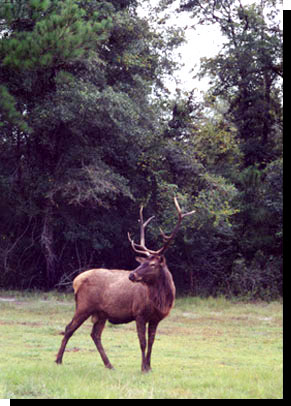| A male elk is a called a bull,
and the female is a cow. The male red deer (and sika) is a "stag" and the female red deer (and sika) is a"hind".
The bull elk's call is a deep, shrill bugle that resonates using his two ivory teeth in the upper jaw, while the red deer's call is a roar. The red deer can make shrill calls too, but when they do roar it's bone
chilling and sounds like an enormous lion. They both vocalize
in several ways, including hoarse, thunderous mooing like a cow, or whining when annoyed
by another bull or stag.
Being genetically close,
red deer and elk interbreed, but like most hybrids their instincts are criss-crossed and they don't usually
thrive in wild conditions. The elk bulls and red deer stags can
also breed the related (and much smaller) sika hinds (The cross cannot go the other way because the tiny sika stags could never mount the huge females.) The male elk--red deer hybrid is a "red stag" (instead of red deer stag), and the hybrid of a sika and elk is called a "silk" deer.
Hybridization, deer
farming and introductions outside of their natural ranges have caused
much genetic mixing, so that we find stray genes in populations of elk, red deer and sika as well. In fact, some of the
subspecies of red deer and sika might be so genetically confused that certain of the pure forms
are already extinct.
There is a dwarf form of wapiti (Tule elk in California), but the larger elk bulls weigh
around 800 lb when lean, then they put on so much added fat during the
summer that their tails can appear pulled in! Their weights then
can be well over 1000 lb. The larger cows are around 400 - 430 lb.
An interesting difference between the wapiti and red deer is that the winter body weights of our wapiti will go up by 150% from their summer weight, but in the red deer the increase can be up to an amazing 500%!
Antlers of elk and red deer are different in shape, texture, maximum number of points, length and weight.
Elk antlers grow up, out and backward, while the red deer's grow up and inward. Elk antlers aren't smooth, but are smoother than red deer antlers which are like rough tree bark.
Elk antlers have a six-tine plan (12 total points) and it's uncommon for them to grow extra points. Three of their tines however
can split in two, so a typical antler can have up to nine points (18 total). But you can still make out the underlying six-tine structure. The basic antler plan for the red deer is a five tines (for ten total points) and it is normal for them to grow additional points.
Compare the elk's maximum 18 points to the record number for the red deer - a German stag with 66 points!
While our wapiti don't win the contest for antler points, they do win it for length and weight. The
record antler length for red deer is a stag from Rumania with antlers over 53". For the wapiti 57" isn't rare, and the record is 67"- that's over five and a half feet! A red deer antler can weigh as much as 20 lb, small change compared to the elk's record of over 35 lb.
Wapiti have thrived in almost every North American habitat, and in the past they lived in Florida - but never in the desert
or tropics. They don't do well in hot climates - dry or wet - and that's why
they never found their way down into South America.
The woods-loving red deer would rather browse than graze. It's the opposite for elk who prefer open plains and graze. But both will easily switch. And they all love to wallow to escape heat and pests.
Wapiti temperment is calmer than the red deer, and elk adjust easily to captivity. Their
red deer cousins tend to be more nervous and excitable. Before the breeding
season both elk and red deer males live together in bachelor groups, and the females
in groups with their young. Then, in the fall the bachelor groups break up, and the dominant males compete for and guard harems.
Bulls and stags, just like whitetail bucks, are crazed and dangerous when they're in full rut, especially if they believe someone is tampering with their harem. Their huge size and lethal antlers increase the danger vastly. They can kill each other with a poke when playing as well fighting. Plus they strike with their huge hooves (And in the red deer, the rear hooves as well as
the front!) They are completely outfitted killing machines. A very strong man can sometimes muscle his way out of a whitetail attack by grabbing its horns, but if an attacking bull or stag is in contact with it's victim, their only hope of survival is luck.
The meat of both
deer is similar with a delicious flavor and juicier texture than most venisons, and you can cook it like beef. For many people it's their favorite wild game meat. Like all game, it's low in fat and cholesterol. |
 Our
5x6 bull elk in splendid condition.
You can see the large, tan rump patch characteristic of the elk.
Our
5x6 bull elk in splendid condition.
You can see the large, tan rump patch characteristic of the elk. One of our majestic red deer. Compare his redder color and smaller rump patch to the elk's.
One of our majestic red deer. Compare his redder color and smaller rump patch to the elk's.